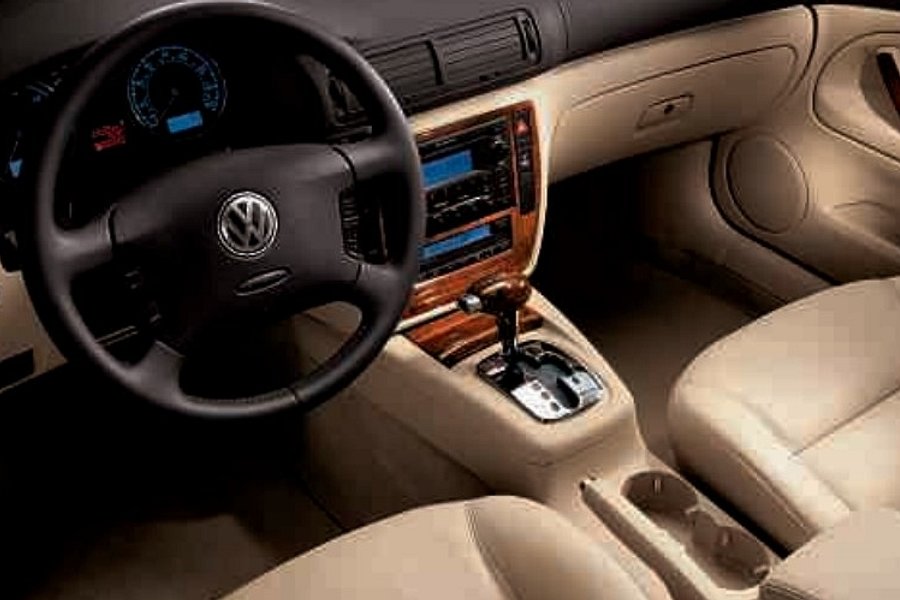1998-2005 Volkswagen Passat Maintenance and Cost
Highly strung and precisely engineered European cars don't do well when neglected, and so it proves with the B5 Passat. Given fresh full-synthetic oil every 5,000 miles and sticking to the service schedule should see it do great mileages, regardless of the engine, but finding one that has been looked after that well might be challenging. We cannot stress enough how important this is on the 1.8 T gas engine. It shouldn't use gallons of oil, and anything less than full-synthetic oil being kept topped up religiously will shorten the engine's life. Insist on a full service history and study it closely for gaps.
On all the engines, minor lube services happen every 5,000 miles, and the fuel filter and cabin air filter should be replaced every 20,000 miles. On the 1.8 T, this 20,000-mile service works out to around $600 at VW or $360 at an independent shop. On the 2.0-liter diesel, these amounts are $700 and $430, respectively; on the 2.8 V6 they are $620 and $380, respectively, and on the W8, they will cost around $640 and $400.
Every 40,000 miles, it's the turn of the spark plugs and the engine's air filter; of course, the diesel doesn't have spark plugs, and its glow plugs last a lot longer. The expected amounts for this service at either VW or an independent shop are $900 and $620 on the 1.8 T, $770 and $500 on the diesel, $1,000 and $710 on the V6, and $1,200 and $880 on the W8.
At 50,000 miles, have the brake fluid replaced. Don't postpone the automatic transmission's oil change beyond 60,000 miles - the approximate cost of $300 is worth it in the long run. 60,000 miles will mean big expenses on the 1.8 T engine because a prudent owner would have the lubrication system cleaned out - including the sump and oil pickup - and have the water pump, thermostat, and timing-belt assembly replaced at the same time. While the V6 will need its ignition coils replaced at 60,000 miles, it is a little more lenient on the other items, and the water pump, thermostat, and timing belt can wait until 75,000 to be replaced. As long as it's received fresh oil every 5,000 miles, the V6 won't need the invasive lubrication system cleanup of the 1.8 T either.











 Acura
Acura
 Alfa Romeo
Alfa Romeo
 Aston Martin
Aston Martin
 Audi
Audi
 Automobili Pininfarina
Automobili Pininfarina
 Bentley
Bentley
 BMW
BMW
 Bollinger
Bollinger
 BrightDrop
BrightDrop
 Bugatti
Bugatti
 Buick
Buick
 Cadillac
Cadillac
 Caterham
Caterham
 Chevrolet
Chevrolet
 Chrysler
Chrysler
 Dodge
Dodge
 Ferrari
Ferrari
 Fiat
Fiat
 Fisker
Fisker
 Ford
Ford
 Genesis
Genesis
 GMC
GMC
 Gordon Murray Automotive
Gordon Murray Automotive
 Hennessey
Hennessey
 Honda
Honda
 Hyundai
Hyundai
 Ineos Automotive
Ineos Automotive
 Infiniti
Infiniti
 Jaguar
Jaguar
 Jeep
Jeep
 Karma
Karma
 Kia
Kia
 Koenigsegg
Koenigsegg
 Lamborghini
Lamborghini
 Land Rover
Land Rover
 Lexus
Lexus
 Lincoln
Lincoln
 Lordstown
Lordstown
 Lotus
Lotus
 Lucid Motors
Lucid Motors
 Maserati
Maserati
 Mazda
Mazda
 McLaren
McLaren
 Mercedes-Benz
Mercedes-Benz
 Mini
Mini
 Mitsubishi
Mitsubishi
 Nissan
Nissan
 Pagani
Pagani
 Polestar
Polestar
 Porsche
Porsche
 Ram
Ram
 Rimac
Rimac
 Rivian
Rivian
 Rolls-Royce
Rolls-Royce
 Spyker
Spyker
 Subaru
Subaru
 Tesla
Tesla
 Toyota
Toyota
 VinFast
VinFast
 Volkswagen
Volkswagen
 Volvo
Volvo